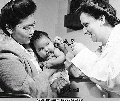|
In post-World War II Alaska, the battle against tuberculosis was the territory's major health issue, especially among Alaska Natives. The crisis led to the creation of a unique health program overseen by Dr. C. Earl Albrecht, Alaska's first full-time Commissioner of Health. Most rural patients could not come to the cities for treatment, so instead the treatment came to the patients in the form of mobile health units traveling on the roads, railroad, and on waterways. This was not the first effort of its kind. In earlier decades, the Bureau of Education operated a "hospital boat" called the Martha Angeline along the Yukon River, and had created a network of rural hospitals and clinics, some staffed, and some served by itinerant doctors and nurses.
In the late 1940s, the Yukon Health tended to villagers' medical needs along the Yukon River. Coastal villagers -- from the Alaska Peninsula to the Aleutian Islands to western Alaska -- were served by two "floating clinics": the M/V Health and M/S Hygiene. Juneau was the homeport for the "health boats," as well as headquarters for the Territorial Department of Health.
Motoring between the coastal communities each spring and/or fall, the ships would radio ahead to each village, letting them know when they expected to anchor. At the ship's horn, local people would take their skiffs out for a checkup or on-the-spot medical care. Today's grandparents tell stories of their teachers canceling school for a day as the children lined up for lung X-rays, inoculations, and teeth-pulling.
In Unga, students wrote up a visit from the Hygiene for their school newspaper, The Alaska Pen. "On the 8th of September (1946), the Public Health boat, the Hygiene, came into the outer harbor of Unga and, after hooting its horn several times, Howard Bentsen responded in a dory and brought the crew ashore. Soon after landing, Dr. Krusich, the medical doctor in charge, made known her plan to have the entire townfolk taken to the boat for X-rays. . . . Howard and Kenneth Foster, being quite familiar with the harbor, volunteered their knowledge and ability to pilot the Hygiene into the inner harbor. To these two boys . . . the people of Unga are indebted for their safe and comfortable trip to and from the boat." The story and others from 1934-1955 were gathered in a book titled An Illustrated History of Unga, by Thor Lauritzen, Peggy Arness, and Edward Melseth.
Although the work of the clinic ships and the other mobile health units improved many lives, TB continued to spread. A 1994 report by the Alaska Natives Commission Health Task Force recounted the numbers: "The territory . . . opened a 150-bed tuberculosis sanitorium at Seward in 1946. Despite these efforts, tuberculosis continued to ravage Alaska Natives. The annual death rate from tuberculosis for Alaska Natives was 653 deaths per 100,000 at a time when the total Native population was only about 34,000. Faced with a Native population being decimated by tuberculosis, Congress in 1949 approved funding for a 400-bed Native hospital in Anchorage that opened in 1953."
Harold Anderson of Chignik Lagoon recalled the "health boat" in 1998 while telling stories about the early days of health care on the Alaska Peninsula, when both traditional healing and modern medicine were used. Born in 1930, Anderson was the son of Olaf Anderson, a Norwegian who arrived on a sailing ship in the early 1900s to become a fish trap boss for the Alaska Packers Association. He fell in love with an Aleut woman and they married and raised a family of 11 children, with Harold as the youngest. They settled in a place called "Greek Point," and Chignik Lagoon became a company settlement for the Norwegians and Swedes who were working the traps.
In the early years, the cannery doctors were on hand to help with medical emergencies, Anderson said. And, once a year, usually in spring when there was still ice in Chignik Bay, the M/V Health arrived and residents boated out to see a doctor or dentist on the floating clinic.
"They did a lot of good, I'm sure," he said, "but we only saw it once a year." Otherwise, if somebody had a toothache, the tooth was pulled with a pair of forceps following a swab of whiskey on a piece of cotton. That's what happened to Anderson when he was 17.
Today, nearly every Alaskan village has a clinic and/or a CHAP aide trained through the Community Health Aides Program established by Dr. Walter Johnson. In 2005, Karen Brewster interviewed Dr. Johnson for Project Jukebox, a digital branch of the University of Alaska Fairbanks Oral History Program. In his interview, Dr. Johnson included a discussion about the history, the present, and the future of rural health care in Alaska. To learn more about CHAP and hear Johnson's interview (tape number H2004-17-06), see the Related Materials section.
|
 |
 |
| Nurse Miss Major was photographed at Tanana |
|
|
|
 |
| Department of Health's Mobile Health Unit truck |
|
|
|
 |
| Aboard the M/S Hygiene in the late 1940s |
|
|
|
 |
| The M/V Health is docked at Dutch Harbor and Unalaska |
|
|
|
 |
| Dr. Hazel Blair |
|
|
|
| Click here for all 11 photos in this gallery. |
|




